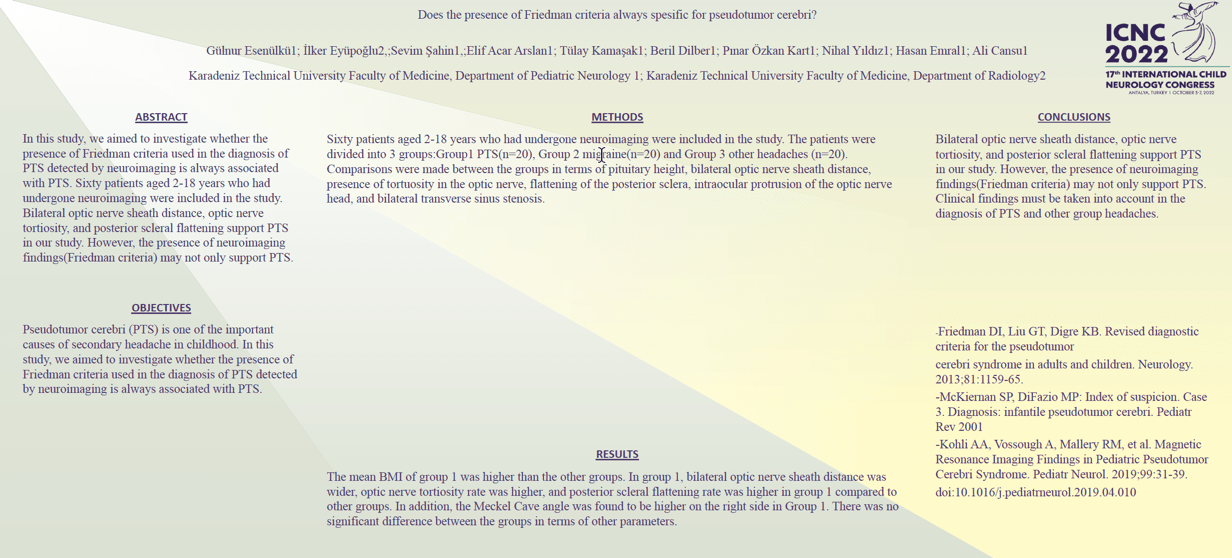Does the presence of Friedman criteria always spesific for pseudotumor cerebri?
Gülnur ESENÜLKÜ, İlker Eyüpoğlu, Tülay Kamaşak, Hasan Emral, Sevim Şahin, Elif Acar Arslan, Beril Dilber, Pınar Özkan Kart, Nihal Yıldız, Ali Cansu
Objective: Pseudotumor cerebri (PTS) is one of the important causes of secondary headache in childhood. In this study, we aimed to investigate whether the presence of Friedman criteria used in the diagnosis of PTS detected by neuroimaging is always associated with PTS. Methods: Sixty patients aged 2-18 years who had undergone neuroimaging were included in the study. The patients were divided into 3 groups:Group1 PTS(n=20), Group 2 migraine(n=20) and Group 3 other headaches (n=20). Comparisons were made between the groups in terms of pituitary height, bilateral optic nerve sheath distance, presence of tortuosity in the optic nerve, flattening of the posterior sclera, intraocular protrusion of the optic nerve head, and bilateral transverse sinus stenosis. Results: The mean BMI of group 1 was higher than the other groups. In group 1, bilateral optic nerve sheath distance was wider, optic nerve tortiosity rate was higher, and posterior scleral flattening rate was higher in group 1 compared to other groups. In addition, the Meckel Cave angle was found to be higher on the right side in Group 1. There was no significant difference between the groups in terms of other parameters. Conclusion: Bilateral optic nerve sheath distance, optic nerve tortiosity, and posterior scleral flattening support PTS in our study. However, the presence of neuroimaging findings(Friedman criteria) may not only support PTS. Clinical findings must be taken into account in the diagnosis of PTS and other group headaches.
Keywords: Friedman criteria, headache, pseudotumor cerebri
Gülnur ESENÜLKÜ
Karadeniz Technical University
Turkey
İlker Eyüpoğlu
Karadeniz Technical University
Turkey
Tülay Kamaşak
Karadeniz Technical University
Turkey
Hasan Emral
Karadeniz Technical University
Turkey
Sevim Şahin
Karadeniz Technical University
Turkey
Elif Acar Arslan
Karadeniz Technical University
Turkey
Beril Dilber
Karadeniz Technical University
Turkey
Pınar Özkan Kart
Karadeniz Technical University
Turkey
Nihal Yıldız
Karadeniz Technical University
Turkey
Ali Cansu
Karadeniz Technical University
Turkey
Objective: Pseudotumor cerebri (PTS) is one of the important causes of secondary headache in childhood. In this study, we aimed to investigate whether the presence of Friedman criteria used in the diagnosis of PTS detected by neuroimaging is always associated with PTS. Methods: Sixty patients aged 2-18 years who had undergone neuroimaging were included in the study. The patients were divided into 3 groups:Group1 PTS(n=20), Group 2 migraine(n=20) and Group 3 other headaches (n=20). Comparisons were made between the groups in terms of pituitary height, bilateral optic nerve sheath distance, presence of tortuosity in the optic nerve, flattening of the posterior sclera, intraocular protrusion of the optic nerve head, and bilateral transverse sinus stenosis. Results: The mean BMI of group 1 was higher than the other groups. In group 1, bilateral optic nerve sheath distance was wider, optic nerve tortiosity rate was higher, and posterior scleral flattening rate was higher in group 1 compared to other groups. In addition, the Meckel Cave angle was found to be higher on the right side in Group 1. There was no significant difference between the groups in terms of other parameters. Conclusion: Bilateral optic nerve sheath distance, optic nerve tortiosity, and posterior scleral flattening support PTS in our study. However, the presence of neuroimaging findings(Friedman criteria) may not only support PTS. Clinical findings must be taken into account in the diagnosis of PTS and other group headaches.
Keywords: Friedman criteria, headache, pseudotumor cerebri
Gülnur ESENÜLKÜ
Karadeniz Technical University
Turkey
İlker Eyüpoğlu
Karadeniz Technical University
Turkey
Tülay Kamaşak
Karadeniz Technical University
Turkey
Hasan Emral
Karadeniz Technical University
Turkey
Sevim Şahin
Karadeniz Technical University
Turkey
Elif Acar Arslan
Karadeniz Technical University
Turkey
Beril Dilber
Karadeniz Technical University
Turkey
Pınar Özkan Kart
Karadeniz Technical University
Turkey
Nihal Yıldız
Karadeniz Technical University
Turkey
Ali Cansu
Karadeniz Technical University
Turkey

Gülnur ESENÜLKÜ
Karadeniz Technical University Turkey
Karadeniz Technical University Turkey